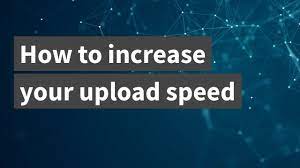Are you frustrated with slow upload speeds? Whether you’re transferring files to the cloud, streaming video online, or sharing large files with your friends and family, there are a few simple steps you can take to increase your upload speed.
Check Bandwidth Limitations.
One of the most common causes of slow upload speeds is a limitation on the amount of data that can be transferred over the connection. In this case, it’s usually the download speed that’s being limited, but it could also be a limitation on how much data can be uploaded to your computer or device in any given time frame. Before making any changes, check to make sure that you’re not being limited by bandwidth restrictions as this will likely have the most significant impact on your upload speed.
Prioritize Connections When Uploading Files.
For the most seamless uploading experience, give priority to connections you’re actively using. If you’re trying to upload a file from your phone while also streaming video or playing games online, those activities will take precedence over the file upload. To maximize upload speed, place these activities on pause until your file has finished uploading. Additionally, close any unnecessary background programs or applications that are active and taking up too much of your device’s resources.
Don’t Miss : Speed Converter
Minimize Travel Times for Data Packets.
Decreasing the distance your data packets need to travel can help increase upload speed. For this, you’ll want to switch to a stable and fast connection as it ensures that there isn’t any interruption in the data packet transfer during your file upload. For example, if you have an Ethernet cable available, it may be better than using a wireless network given that cables offer a more reliable connection with less lag time compared to Wi-Fi. The shorter physical distance that the data travels will reduce overall latency and give you faster file uploads than the slower Wi-Fi signal would.
Tweak Your Network Configuration Settings.
Adjusting your network configuration settings can help to speed up your uploads. Depending on the router and modem you are using, there may be settings available such as bandwidth prioritization or QoS (Quality of Service) algorithms that will give you more control over how your device is able to interact with other devices and networks. Be sure to consult with a professional if possible to make sure you are making the changes correctly.
Use a Paid Download Accelerator Service.
Download accelerator services are specialized software that specifically provide ways to speed up the transfer of your larger data files from one device to another. They work by splitting a file into multiple bits and downloading them simultaneously, allowing for faster speeds and generally better security due to encryption protocols. Premium download accelerator services tend to be more expensive but offer more features, such as the ability to pause or resume downloads.
